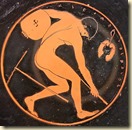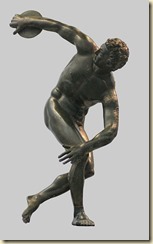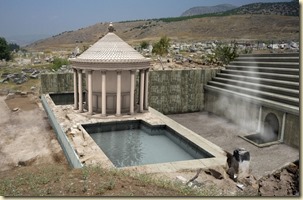Archive for the ‘Ancient Greece’ Category
By: The Scribe on July, 2013
 While modern Olympic athletes train in specific sports for years and years to be the best in their area, the athletes of ancient Greece had a much more intense calling, specifically those who competed in the Pentathlon. The Pentathlon was made up of five different events, and while we don’t have any surviving texts that explain exactly what qualified someone as the “winner” of the event, we do know that the “Ultimate Victor” needed to win three of the five events. Take that, modern pentathlon!
While modern Olympic athletes train in specific sports for years and years to be the best in their area, the athletes of ancient Greece had a much more intense calling, specifically those who competed in the Pentathlon. The Pentathlon was made up of five different events, and while we don’t have any surviving texts that explain exactly what qualified someone as the “winner” of the event, we do know that the “Ultimate Victor” needed to win three of the five events. Take that, modern pentathlon!
Discus throwing was one of the five events in the ancient pentathlon (and is not included in the modern version). It’s an event in which an athlete throws a heavy disc, or “discus”, as far as possible. The winner is the athlete who can throw it farther than the other competitors.
Present evidence dates the ancient pentathlon, and discus throwing, as far back as 708 B.C. Originally, the discus was shaped out of stone, though later versions were made of bronze, lead, or iron—which we know from archaeological excavations that have found ancient discs from the sport!
 The diameter of the excavated discs ranges from between 17 and 35 centimeters, and they tend to weigh between 1.3 and 6.6 kg—quite the range of size and weight, but written evidence provides an explanation: Each city where athletes trained had its own weight standard, while some major differences come as a result of differently sized discs for men versus boys.
The diameter of the excavated discs ranges from between 17 and 35 centimeters, and they tend to weigh between 1.3 and 6.6 kg—quite the range of size and weight, but written evidence provides an explanation: Each city where athletes trained had its own weight standard, while some major differences come as a result of differently sized discs for men versus boys.
When it came to the Olympics, however, three discs of standardized sizes were kept in the Sikyonian treasury. Gotta keep things fair, after all!
The sport’s enduring legacy through the millennia is probably helped by several ancient Greek statues and paintings of discus throwers—notably, Myron’s Discobolus statue (pictured to the left) from the 5th century B.C.

By: The Scribe on June, 2013
 Solstice is word that gets tossed around several times a year, and today marks the first day of summer for 2013—the Summer Solstice, if you will. But what does solstice actually mean, and where did this word and concept come from?
Solstice is word that gets tossed around several times a year, and today marks the first day of summer for 2013—the Summer Solstice, if you will. But what does solstice actually mean, and where did this word and concept come from?
Simply put, a solstice is an astronomical event that happens twice a year, when the Sun reaches its highest or lowest point relative to “celestial equator” on the “celestial sphere.” The term itself comes from the Latin words sol (meaning ‘sun”) and sistere (meaning “to stand still”).
It was actually the ancient Greeks who were responsible for the concept of the “celestial sphere”, though they also believe that the stars rotated around the Earth over the course of a day—and that the Earth remained stationary. They thought that the stars were part of an invisible stationary surface, keeping them fixed and rotating. (This concept actually forms the basis of some modern astronomical thought, wherein the celestial sphere is acknowledged to exist, though only the stars rotate and not the sphere itself.)
Why is this important? In terms of the summer, it was through the acknowledgement of a Summer Solstice that some Greeks were able to make important and valuable contributions to science and our understanding of the Earth.
 We know that one ancient Greek astronomer named Aristarchus observed a Summer Solstice in 280 B.C., and he was responsible for proposing the heliocentric hypothesis: the earth revolves around the sun, and not the other way around. Sadly for Aristarchus, the idea wasn’t popular during his lifetime, and it was only when Copernicus made the same claim 1800 years later that it gained any ground.
We know that one ancient Greek astronomer named Aristarchus observed a Summer Solstice in 280 B.C., and he was responsible for proposing the heliocentric hypothesis: the earth revolves around the sun, and not the other way around. Sadly for Aristarchus, the idea wasn’t popular during his lifetime, and it was only when Copernicus made the same claim 1800 years later that it gained any ground.
Another ancient Greek, a mathematician and geographer named Eratosthenes, was able to calculate the circumference of the Earth after observing the sun’s shadow at the Summer Solstice’s noon in Alexandria and Syene. By knowing the geographical distance between the two cities, he calculated a circumference of about 250,000 stadia—or 24,662 miles.
The Summer Solstice has traditionally had less of an “urgent” feel about it—we’re not heading into winter, dreading the loss of the sun—but it has still contributed to scientific advancement both in ancient and modern times, and thus has an important place in human history!

By: The Scribe on April, 2013
 Sorry, Buffy, but it looks like your small town problems were nothing compared to the real Hellmouth discovered by Italian archaeologists in southwestern Turkey!
Sorry, Buffy, but it looks like your small town problems were nothing compared to the real Hellmouth discovered by Italian archaeologists in southwestern Turkey!
Whether the Slayers of ancient times knew about it or not (Editor’s Note: Yes, we know Buffy is fictional. No, we don’t particularly care.), the ruins from Turkey are known as Pluto’s Gate or “Plutonium” in Latin, and during its time it appears that a cave among the ruins was known in Greco-Roman tradition & mythology as a portal to the underworld.
The cave ruins are located in an ancient Phrygian city called Hierapolis, and the ancient geographer Strabo described the site as being “full of a vapor so misty and dense that one can scarcely see the ground. Any animal that passes inside meets instant death.”
Writing sometime between 7-18 AD, Strabo says he conducted an experiment at this site during ancient times: “I threw in sparrows and they immediately breathed their last and fell.”
And now we know exactly where that hellmouth is!
The location was announced at an Italian archaeology conference in March 2013, with the find made by a team from the University of Salento. Lead archaeologist Francesco D’Andria says the team “found the Plutonium by reconstructing the route of a thermal spring.” During the excavation, they observed the death of several birds who died as they tried to get close to the opening’s warmth… and were immediately killed by the lethal carbon dioxide fumes.
 Once excavated, the team found Ionic columns with a dedication inscription to two well-known underworld deities, Pluto and Kore—or perhaps better known by their Greek names, Hades and Persephone. The team also found temple remains, steps, and a pool that matched the ancient source material descriptions.
Once excavated, the team found Ionic columns with a dedication inscription to two well-known underworld deities, Pluto and Kore—or perhaps better known by their Greek names, Hades and Persephone. The team also found temple remains, steps, and a pool that matched the ancient source material descriptions.
D’Andria mentioned that small birds were given to pilgrims at the cave opening so that they could test the deadliness at its mouth, providing a sort of ancient tourist attraction… and of course, there were priests at the location too. In this case, they did a lot of bull sacrificing to Pluto. While hallucinated, of course (would you expect anything less?)—the priests would drag the animals into the cave, wait for them to die, and then drag them out.
It’s thought that the groundwater pool at Hierapolis gave off fumes that caused a hallucinogenic effect similar to that at Delphi, which was another incentive for pilgrims to visit—they could see visions of their futures and receive prophecies by sleeping between the cave mouth and the water.
The site was a popular destination until sometime in the 4th-century AD, and infrequently afterward until its destruction in the 6th-century… was a Slayer responsible for closing this particular hellmouth, too? That’s for you to decide…

By: The Scribe on April, 2012
 That’s right—Kordax of DC Comics fame, while possessing a cool name and a backstory based on pseudo-Ancient-Greek history (er, he is Atlantean, after all), was not originally a comic book character.
That’s right—Kordax of DC Comics fame, while possessing a cool name and a backstory based on pseudo-Ancient-Greek history (er, he is Atlantean, after all), was not originally a comic book character.
Oh my, the shock!
No, in fact, the term kordax refers to something completely different… something which may make you look a little differently upon Aquaman’s ancestor the next time you pick up a copy of The Atlantis Chronicles.
The kordax, in Ancient Greek history, was a dance performed by men during comedic plays, such as those written by playwright Aristophanes.
The dance itself was… less of a piece of “choreographed movement” than other Greek dances performed by choruses. Those other dances were taught to young soldiers as part of their military training in formation and strategic movement. The kordax? Well, it was more like… drunken frat party carousing.
Scholars have referred to the kordax as “lascivious”, “vulgar”, “obscene”, and “lewd”. There is some debate over whether the dance had received this kind of connotation during the 6th-century when it was performed, or whether that’s a more recent development. Either way, the depictions of the dance on Ancient Greek vases show men with certain “enhancements” in “unique” poses (Scribe’s note: We’re trying to keep this family friendly, here…) that are believed to be artistic depictions of the men in costume and performing the kordax.
 There are also some who believe the kordax was a masked solo performance, which makes it very unlike the large-group chorus dances performed during tragedies and other plays. From what scholars can interpret based on artistic and written information, it was a vigorous, acrobatic dance that relied mostly on leg movements, with padding placed around the belly and buttocks (ie. the “enhancements” previously mentioned…).
There are also some who believe the kordax was a masked solo performance, which makes it very unlike the large-group chorus dances performed during tragedies and other plays. From what scholars can interpret based on artistic and written information, it was a vigorous, acrobatic dance that relied mostly on leg movements, with padding placed around the belly and buttocks (ie. the “enhancements” previously mentioned…).
It’s thought to have originated as a fertility dance, which makes an odd sort of sense, considering the ties of comedy to Dionysus, drinking, and grapes (which were all symbolic of fertility in one way or another).
And while we don’t have Ancient Greek YouTube videos to show us exactly how the dance was done, at least we have DC Comics, who likely didn’t expect anyone to put the originally meaning of “kordax” together with their character’s name… talk about an awkward moment, hmm?

Previous page | Next page
 While modern Olympic athletes train in specific sports for years and years to be the best in their area, the athletes of ancient Greece had a much more intense calling, specifically those who competed in the Pentathlon. The Pentathlon was made up of five different events, and while we don’t have any surviving texts that explain exactly what qualified someone as the “winner” of the event, we do know that the “Ultimate Victor” needed to win three of the five events. Take that, modern pentathlon!
While modern Olympic athletes train in specific sports for years and years to be the best in their area, the athletes of ancient Greece had a much more intense calling, specifically those who competed in the Pentathlon. The Pentathlon was made up of five different events, and while we don’t have any surviving texts that explain exactly what qualified someone as the “winner” of the event, we do know that the “Ultimate Victor” needed to win three of the five events. Take that, modern pentathlon! The diameter of the excavated discs ranges from between 17 and 35 centimeters, and they tend to weigh between 1.3 and 6.6 kg—quite the range of size and weight, but written evidence provides an explanation: Each city where athletes trained had its own weight standard, while some major differences come as a result of differently sized discs for men versus boys.
The diameter of the excavated discs ranges from between 17 and 35 centimeters, and they tend to weigh between 1.3 and 6.6 kg—quite the range of size and weight, but written evidence provides an explanation: Each city where athletes trained had its own weight standard, while some major differences come as a result of differently sized discs for men versus boys. 





